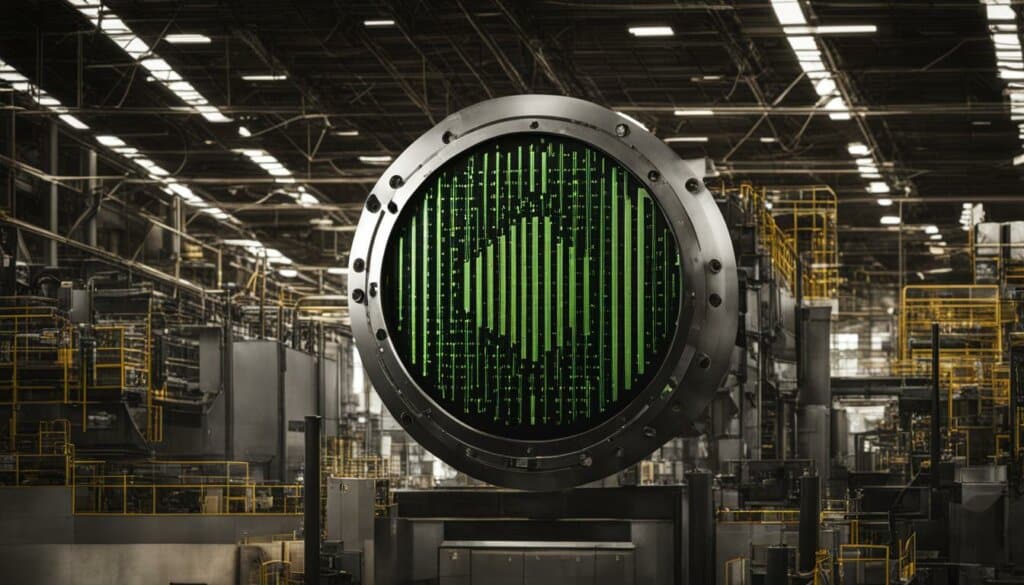Table of Contents
The manufacturing industry is facing increasing cybersecurity risks due to the rise of digital technologies and smart factories. Cybersecurity in the manufacturing industry is of utmost importance to protect critical assets, maintain operational efficiency, and mitigate the risks associated with cyber attacks. In this article, we will explore the cybersecurity measures that manufacturing organizations need to adopt and the best practices they should follow to ensure a secure environment.
With the advancement of technology, manufacturing companies are exposed to various cyber threats that can compromise people, technology, processes, and intellectual property. It is essential for manufacturing organizations to implement robust cybersecurity measures to protect against these threats. By focusing on cybersecurity in the manufacturing industry, companies can safeguard their operations and maintain their competitive edge.
In the following sections, we will delve into the current cyber landscape in manufacturing, the impact of IT and OT misalignment, building cyber resilience in smart factories, the role of emerging technologies in cyber risks, intellectual property theft, and nation-state attacks. We will also discuss the top cybersecurity risks faced by manufacturing companies and considerations for enhancing manufacturing cybersecurity.
Stay tuned to learn how the manufacturing industry can address cybersecurity concerns and adopt best practices to ensure a secure and resilient environment.
The Current Cyber Landscape in Manufacturing
The manufacturing industry is facing a growing number of cyber threats and risks in today’s digital landscape. As smart factories become more interconnected, they create new opportunities for cybercriminals to exploit vulnerabilities in operational technologies (OT). According to the Cybersecurity and Infrastructure Security Agency (CISA), there are over 1,200 known security issues, vulnerabilities, and exploits in the OT used in manufacturing. This alarming number highlights the urgent need for manufacturing companies to strengthen their cybersecurity capabilities to protect against attacks.
Many manufacturing organizations lack the necessary cybersecurity measures to secure their critical systems effectively. In fact, few have conducted cybersecurity assessments in the past six months, leaving them vulnerable to potential threats. With the rise of IoT devices and emerging technologies, such as AI, ML, and big data analytics, the attack surface in manufacturing has expanded, increasing the risk of cyber attacks.
In order to ensure the security of manufacturing systems, companies must invest in robust cybersecurity solutions and adopt best practices. This includes performing regular cybersecurity assessments to identify vulnerabilities, establishing formal cybersecurity governance programs, and prioritizing actions based on risk profiles. By implementing these measures, manufacturing organizations can better protect their valuable data and minimize the potential impact of cyber attacks.
The Current Cyber Landscape in Manufacturing
| Key Cyber Risks | Potential Impact |
|---|---|
| Network and application anomalies | Data breaches, business disruption |
| System anomalies | Financial loss |
| Malware attacks | Loss of sensitive data |
The Impact of IT and OT Misalignment
The misalignment between information technology (IT) and operational technology (OT) in manufacturing poses a significant cybersecurity risk. The convergence of IT and OT requires the integration of different technologies, often with different security control capabilities. Many manufacturing companies have yet to build the necessary cyber capabilities to secure their industrial control systems. This lack of alignment and preparedness leaves the manufacturing industry vulnerable to new threats arising from the adoption of IoT devices and emerging technologies.
In smart factories, IT systems are responsible for managing administrative tasks, such as data processing and communication, while OT systems control and monitor physical devices and processes. However, the interaction of these systems creates potential vulnerabilities that can be exploited by cybercriminals. For example, an attack on the IT network can potentially affect the OT systems, causing disruptions or even physical damage to the manufacturing process.
To address the impact of IT and OT misalignment on cybersecurity, manufacturing companies need to implement appropriate cybersecurity controls in smart factories. This includes establishing clear segmentation between IT and OT networks to prevent unauthorized access and implementing robust authentication methods for IoT devices. Additionally, regular monitoring and assessment of the security posture of both IT and OT systems are essential to identify and address any vulnerabilities.
| IT and OT Misalignment | Cybersecurity Controls in Smart Factories | Securing Industrial Control Systems |
|---|---|---|
| Lack of alignment between IT and OT systems | Safeguarding against potential vulnerabilities in smart factories | Implementing strong security measures for industrial control systems |
| Potential for cyber attacks to impact physical processes | Establishing clear segmentation between IT and OT networks | Regular monitoring and assessment of security posture |
| Increased risk arising from the adoption of IoT devices | Implementing robust authentication methods for IoT devices | Identifying and addressing vulnerabilities |
By addressing the misalignment between IT and OT systems and implementing appropriate cybersecurity controls, manufacturing companies can enhance their resilience to cyber threats and protect their industrial control systems from potential attacks.
Building Cyber Resilience in Smart Factories
To address the increasing cybersecurity concerns in the manufacturing industry, organizations must prioritize the development of a comprehensive cyber management program that extends across the entire enterprise. This program should encompass various initiatives aimed at building cyber resilience in smart factories and protecting valuable manufacturing data.
One crucial step is to perform regular cybersecurity maturity assessments. These assessments allow organizations to evaluate their current cybersecurity capabilities and identify areas of improvement. By understanding their strengths and weaknesses, manufacturers can effectively prioritize their cybersecurity investments and allocate resources where they are most needed.
In addition to maturity assessments, establishing a formal cybersecurity governance program is essential. This program should define clear roles and responsibilities for cybersecurity management, ensuring that all stakeholders are aligned and accountable for protecting manufacturing data. Cybersecurity governance provides a framework for decision-making and ensures that security measures are consistent and effective throughout the organization.
Key Considerations for Cybersecurity Risk Management in Manufacturing:
- Perform cybersecurity maturity assessments to identify strengths and weaknesses
- Establish a formal cybersecurity governance program
- Prioritize actions based on risk profiles
- Build security measures into smart factory initiatives
- Improve cybersecurity awareness among employees
- Protect manufacturing data from unauthorized access
Furthermore, building cyber resilience in smart factories requires a proactive approach to risk management. Manufacturers should prioritize actions based on their risk profiles and allocate resources accordingly. This involves implementing security measures that address the specific vulnerabilities and threats faced by the organization.
Finally, improving cybersecurity awareness among employees is crucial for maintaining a strong cyber defense. Regular training programs and awareness campaigns can help educate employees about the importance of cybersecurity and equip them with the knowledge and skills to identify and report potential threats. By fostering a cyber-conscious culture, organizations can ensure that every individual is actively involved in protecting valuable manufacturing data.
By investing in cybersecurity risk management and taking the necessary precautions, manufacturing organizations can protect their operations, data, and intellectual property from cyber threats. Building cyber resilience in smart factories is a continuous process that requires ongoing vigilance and adaptation to emerging risks. However, by prioritizing cybersecurity and adopting industry best practices, manufacturers can mitigate the risks associated with cyber attacks and maintain a secure digital environment.

The Role of Emerging Technologies in Cyber Risks
The manufacturing industry is increasingly embracing emerging technologies such as artificial intelligence (AI), machine learning (ML), big data analytics, Internet of Things (IoT), and industrial Internet of Things (IIoT) to drive innovation and improve operational efficiency. However, these technologies also introduce new cyber risks and vulnerabilities that manufacturers need to address in order to protect their critical assets and data.
AI and ML, which enable machines to learn and make decisions autonomously, can be exploited by cybercriminals to launch sophisticated attacks. Vulnerabilities in AI and ML algorithms can be manipulated to deceive or mislead systems, leading to potential security breaches and data manipulation. It is essential for manufacturing companies to implement robust security measures and regularly update their AI and ML systems to mitigate these vulnerabilities.
Big data analytics plays a crucial role in enabling manufacturers to extract valuable insights from vast amounts of data. However, the security of this data becomes a concern when it is stored, processed, and transmitted across networks. Manufacturers must ensure the confidentiality, integrity, and availability of their data by implementing encryption techniques, access controls, and secure data transfer protocols.
Emerging technologies such as AI, ML, big data analytics, IoT, and IIoT increase the attack surface for cybercriminals and create potential vulnerabilities that can be exploited.
The widespread adoption of IoT and IIoT devices in smart factories enables seamless connectivity and data sharing between machines, sensors, and other operational assets. However, these devices often have limited security features, making them attractive targets for cyber attacks. Manufacturers must implement stringent security controls, such as device authentication, network segmentation, and regular firmware updates, to prevent unauthorized access and protect their IoT and IIoT ecosystems.
In conclusion, while emerging technologies offer significant opportunities for the manufacturing industry, they also bring inherent cybersecurity risks. Manufacturers must prioritize the implementation of robust security measures and stay vigilant against evolving threats to safeguard their critical assets, data, and operational processes.
| Technology | Cyber Risks |
|---|---|
| Artificial Intelligence (AI) | Potential vulnerabilities in algorithms leading to security breaches and data manipulation |
| Machine Learning (ML) | Risk of manipulation of ML systems to deceive or mislead |
| Big Data Analytics | Security concerns around the storage, processing, and transmission of data |
| Internet of Things (IoT) and Industrial Internet of Things (IIoT) | Limited security features in devices and potential unauthorized access |
Intellectual Property Theft and Nation-State Attacks
The manufacturing industry is increasingly targeted by cyber espionage and nation-state sponsored attacks, posing a significant threat to intellectual property. These attacks aim to steal sensitive data and trade secrets, resulting in a loss of competitive advantage and potential economic disadvantage for manufacturing companies.
Cyber espionage in manufacturing involves the covert infiltration and theft of valuable intellectual property, including proprietary manufacturing processes, designs, and customer data. Nation-state actors often sponsor these attacks, leveraging advanced persistent threats and sophisticated techniques to gain unauthorized access to manufacturing networks.
To protect against intellectual property theft and nation-state attacks, manufacturing organizations must implement robust cybersecurity measures. This includes establishing strong perimeter defenses, such as firewalls and intrusion detection systems, to prevent unauthorized access. Additionally, implementing multifactor authentication and encryption protocols can enhance data security and prevent unauthorized data exfiltration.
| Cybersecurity Measures | Description |
|---|---|
| Regular Security Audits | Conduct regular audits to identify vulnerabilities and implement necessary security patches. |
| Employee Training | Provide comprehensive cybersecurity training to employees to raise awareness and promote best practices. |
| Secure Supply Chain | Implement mechanisms to ensure the security of the supply chain, including verifying third-party vendors’ cybersecurity measures. |
| Incident Response Plan | Develop and regularly test an incident response plan to minimize the impact of cyber attacks and facilitate timely recovery. |
By adopting a proactive approach to cybersecurity, manufacturing companies can defend against intellectual property theft and nation-state attacks. Regular security audits, comprehensive employee training, securing the supply chain, and developing an incident response plan are crucial steps in safeguarding valuable intellectual property and maintaining a competitive edge in the industry.
Top Cybersecurity Risks for Manufacturing Companies
The manufacturing industry faces numerous cybersecurity vulnerabilities and risks, which can result in severe consequences such as data breaches, operational disruptions, and financial losses. It is crucial for manufacturing organizations to understand and address these risks to protect their valuable assets and maintain a secure operational environment.
Main Cybersecurity Risks in Manufacturing
The following table highlights the top cybersecurity risks faced by manufacturing companies:
| Risk | Description | Impact |
|---|---|---|
| Network and Application Anomalies | Unusual network traffic or abnormal behavior in applications that may indicate a cyber attack or unauthorized access. | Potential data breaches, compromised systems, and disruption of critical operations. |
| System Anomalies | Unexpected behaviors or errors in industrial control systems, indicating potential cyber threats or vulnerabilities. | Possible disruption of manufacturing processes, equipment malfunctions, or safety risks. |
| Malware Attacks | Malicious software designed to infiltrate or damage computer systems and networks. | Potential loss of sensitive data, operational disruptions, financial losses, and reputational damage. |
Manufacturing companies must be proactive in addressing these risks by implementing robust cybersecurity measures, including network monitoring, anomaly detection systems, and malware protection.
“Cybersecurity in the manufacturing industry is crucial to safeguard critical assets, prevent data breaches, and maintain uninterrupted operations. Failure to address these risks can result in significant financial and reputational damages.”
It’s also important for organizations to regularly update their cybersecurity protocols and educate employees about best practices to create a cyber-conscious culture. By taking a comprehensive approach to cybersecurity, manufacturing companies can reduce their vulnerability to cyber attacks and protect their valuable assets.
Cybersecurity Best Practices for Manufacturing
In today’s digital era, the manufacturing industry is increasingly vulnerable to cyber threats. To protect sensitive data, intellectual property, and ensure the smooth operation of smart factories, manufacturing companies need to implement cybersecurity best practices. Here are some key considerations for enhancing manufacturing cybersecurity:
1. Conduct Regular Risk Assessments:
Performing regular risk assessments is crucial for understanding the vulnerabilities and potential threats to your manufacturing network. Identify the critical assets, systems, and processes that require the highest level of protection. This will enable you to prioritize your cybersecurity efforts and allocate resources effectively.
2. Build a Robust Cybersecurity Governance Program:
Establishing a formal cybersecurity governance program is essential for creating a structured approach to cybersecurity management. This program should include policies and procedures that address all aspects of cybersecurity, from access controls to incident response. It should also outline accountability and responsibility for cybersecurity at all levels of the organization.
3. Implement Security Measures in Smart Factory Initiatives:
Security should be built into the design and implementation of smart factory initiatives. This includes integrating cybersecurity controls into the network infrastructure, implementing secure coding practices for software development, and ensuring secure communication between devices and systems. Regularly update and patch software and firmware to address known vulnerabilities.
4. Invest in Cybersecurity Training and Awareness:
Employees play a critical role in preventing cyber attacks. Provide comprehensive cybersecurity training to all staff members to educate them about potential threats and best practices for protecting sensitive information. Foster a culture of cybersecurity awareness, where employees are encouraged to report any suspicious activities or potential security breaches.
5. Secure Manufacturing Networks:
Implementing robust network security measures is vital to protect manufacturing networks from unauthorized access and cyber threats. Use firewalls and intrusion detection systems to monitor and control network traffic. Implement strong authentication methods, such as multi-factor authentication, to ensure that only authorized individuals can access critical systems and data.
By implementing these cybersecurity best practices, manufacturing companies can significantly enhance their defenses against cyber threats and protect their valuable assets. It is important to stay vigilant, adapt to emerging risks, and continuously update security measures to stay one step ahead of cybercriminals.
| Cybersecurity Best Practices for Manufacturing |
|---|
| 1. Conduct Regular Risk Assessments |
| 2. Build a Robust Cybersecurity Governance Program |
| 3. Implement Security Measures in Smart Factory Initiatives |
| 4. Invest in Cybersecurity Training and Awareness |
| 5. Secure Manufacturing Networks |

Conclusion
The manufacturing industry is facing increasing cybersecurity challenges as it embraces digital technologies and smart factory initiatives. With the rise of interconnected smart factory technologies, the industry is exposed to a proliferation of cyber threats. The misalignment between information technology (IT) and operational technology (OT) in manufacturing poses a significant risk, leaving the industry vulnerable to new threats arising from the adoption of IoT devices and emerging technologies.
To address these concerns, manufacturing organizations must prioritize cybersecurity measures and invest in robust cyber management programs. This involves performing cybersecurity assessments, establishing formal governance programs, and building security measures into smart factory initiatives. Enhancing cybersecurity awareness among employees and securing manufacturing networks are crucial steps in mitigating cyber risks.
Additionally, the adoption of emerging technologies introduces new vulnerabilities that cybercriminals can exploit. Intellectual property theft, often sponsored by nation-states, is a major concern for manufacturing companies. To protect critical assets and maintain operational efficiency, manufacturing organizations need to implement proper security measures and stay vigilant against emerging threats.
By prioritizing cybersecurity, aligning IT and OT systems, and building cyber resilience in smart factories, the manufacturing industry can mitigate the risks associated with cyber attacks. It is crucial for manufacturing organizations to invest in robust cybersecurity programs and continuously adapt to the evolving cyber landscape. By doing so, they can ensure the security of their operations, protect sensitive data, and maintain a competitive advantage in the digital era.
FAQ
What are the biggest cybersecurity risks in the manufacturing industry?
The manufacturing industry faces risks such as operational risks, cyber threats in smart factories, intellectual property theft, and nation-state attacks.
How many known security issues are there in manufacturing operational technologies?
The Cybersecurity and Infrastructure Security Agency (CISA) lists over 1,200 known security issues, vulnerabilities, and exploits in operational technologies (OT) used in manufacturing.
How are IT and OT misalignment posing a cybersecurity risk in manufacturing?
The convergence of IT and OT requires integrating technologies with different security control capabilities, leaving manufacturing companies vulnerable to new threats arising from the adoption of IoT devices and emerging technologies.
What measures can manufacturing organizations take to enhance cybersecurity?
Manufacturing organizations can invest in holistic cyber management programs, perform cybersecurity maturity assessments, establish cybersecurity governance programs, prioritize actions based on risk profiles, build security measures into smart factory initiatives, and improve cybersecurity awareness among employees.
What are the cybersecurity risks associated with emerging technologies in manufacturing?
Emerging technologies like AI, ML, big data analytics, IoT, IIoT, 5G, robotics, 3D printing, and VR/AR increase attack surfaces and potential vulnerabilities exploited by cybercriminals, requiring proper security measures to mitigate the risks.
What is the concern with intellectual property theft in manufacturing?
Intellectual property theft can lead to loss of competitive advantage and economic disadvantage for manufacturing companies, with cyber espionage, often sponsored by nation-states, posing a significant threat if sensitive data and trade secrets are stolen.
What are some common cybersecurity risks faced by manufacturing companies?
Manufacturing companies face risks such as network and application anomalies, system anomalies, and malware attacks, which can result in data breaches, business disruption, and financial loss.
What considerations should manufacturing companies have for enhancing cybersecurity?
Manufacturing companies should prioritize risk assessments, establish formal cybersecurity governance programs, build security measures into smart factory initiatives, invest in cybersecurity training and awareness programs for employees, secure manufacturing networks, and adopt proper authentication methods for IoT devices.
Source Links
- https://www2.deloitte.com/us/en/pages/energy-and-resources/articles/smart-factory-cybersecurity-manufacturing-industry.html
- https://www2.deloitte.com/us/en/pages/manufacturing/articles/cyber-risk-in-advanced-manufacturing.html
- https://www.upguard.com/blog/cybersecurity-in-the-manufacturing-industry













